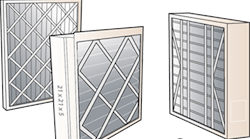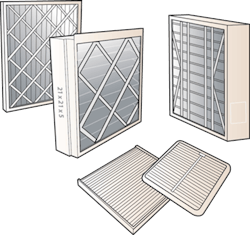Rule-of-thumb assumptions have always been around in our industry. We often associate them with duct design and equipment sizing, but they also carry over to equipment component selection. If you plan on performing any duct renovation, these assumptions can derail your results before you fix the first duct.
However, there is good news. You can prevent potential problems with a little research and planning. Let’s look at four equipment specifications you should check before upgrading any duct system. They might mean the difference between a successful or a failed renovation.
Equipment Capacity
The first specification that can derail a duct renovation is equipment capacity. Before you touch any ducts, verify proper sizing of the existing or replacement equipment. Avoid rules of thumb. They will only get you into trouble here. The “500 sq. ft. per ton” rule of thumb has turned more duct renovations into failures than all the other assumptions combined.
Most heating and cooling equipment is drastically oversized. A big reason for this practice is to cover for poor workmanship. If you renovate a duct system, you’re correcting duct system defects and eliminating existing duct issues. More heating and cooling will now make it into the living space, and the oversizing becomes even more apparent.
Use industry-approved sizing methods like ACCA Manual J and S to determine the right capacity for the home where you’re renovating ducts. If the existing equipment is oversized, that’s great news! Once correctly sized equipment is in place, existing ducts might not need as much work. If existing equipment is right-sized, look at the next three components that influence static pressure and airflow delivery.
Blower Capacity
The second specification that can derail a duct renovation involves the air handler. The blower in the air handling equipment must be strong enough to move the proper amount of air through the duct system.
Manufacturers design most residential blowers to operate below a maximum-rated total external static pressure (TESP) of .50 in. w.c. (inches of water column). Typical air handling equipment can’t move the needed airflow when operating TESP exceeds this rating.
However, some blowers cannot move the required airflow, even operating below the maximum-rated TESP. The only way to find these weaker blowers is to do research. Start with blower performance tables for the air handling equipment you plan to use to see how much airflow it can handle at maximum rated TESP.
Weaker blowers can barely handle adding a coil and filter. If you use a rule-of-thumb duct system in this scenario, you’ve set up a duct renovation for failure.
Coil Pressure Drop
Indoor coil pressure drop is the third specification that can ruin a duct renovation. Higher efficiency indoor coils have more fins per inch across the coil’s surface and are thicker than previous models. This often results in coils that are too restrictive to airflow. As a result, operating TESP can exceed 200% or more of maximum rated TESP. Because of excessive coil resistance, the equipment’s airflow could be less than half of what it should be.
To prevent this problem, refer to manufacturer coil pressure-drop data before you resize your ducts. Look for the coil’s wet/dry condition and desired fan airflow. From this information, you can determine if the coil pressure drop falls within an acceptable range. Ideally, the coil pressure drop should not exceed .20 to .30-in. w.c. If it does, find a different coil model with less resistance.
Filter Size and Media Type
The last specification that can impact a duct renovation is the most obvious - air filter pressure drop. Many filters are undersized or too restrictive for the media type used. You can keep yourself safe when sizing filters if you keep filter face velocity, measured in feet per minute (fpm), below manufacturer recommendations.
For example, 300 fpm is a common manufacturer recommendation. However, you may need to size more restrictive filters at a lower velocity. This step assures the filter is large enough and won’t restrict airflow.
If you’re lucky enough to find the filter manufacturer’s pressure drop tables, ideal filter pressure drop should not exceed 20% of the maximum-rated TESP at required airflow. When filter pressure drop is higher, consider increasing the filter size or find less restrictive media. It sounds simple, but if overlooked, the air filter can hinder an entire renovation project.
Look to Manufacturer Specifications
Don’t guess. Instead, review manufacturer specifications for any components you plan to reuse in a renovation. When you check these specifications, pay special attention to the ratings and then compare them to your actual measurements and requirements. They could reveal the need for other options or additional work.
Consider these questions when you review blower capacity:
· What is the blower airflow capacity at different TESP and fan speeds?
· Do I have extra blower capacity if I need it?
· Can the blower move the required airflow through the coil and filter I plan to use?
· Is there a better equipment choice that will provide me with more airflow?
Consider these questions when you review manufacturer coil data:
· What is the pressure drop over the coil at the required airflow?
· What is the pressure drop difference between a wet coil and dry coil?
· How much of the fan’s capacity will this coil use up?
· Is there a better coil match offering a lower pressure drop?
Consider these questions when you review manufacturer filter data:
· What is the pressure drop over the filter at the required airflow?
· Do I need to go with a larger filter size to keep pressure drop low?
· Should I use multiple filters to achieve a lower pressure drop?
Reviewing these specifications takes a little time, but can save you a lot of trouble by heading off problems before they occur. Take a few minutes to investigate your airside component selection to discover potential problems before you renovate the ducts connected to them. It’s a lot more expensive to correct these problems after your customer invested in the duct renovation. Don’t harm a good relationship by forgetting to review the manufacturer’s data.
David Richardson serves the HVAC industry as Vice President of Training for the National Comfort Institute, Inc. (NCI). NCI specializes in training that focuses on improving, measuring, and verifying HVAC and Building Performance.
If you’re an HVAC contractor or technician interested in learning about duct renovation, contact David at ncilink.com/ContactMe. NCI’s website www.nationalcomfortinstitute.com is full of free information to help you improve your professionalism and strengthen your company.
Photo Captions
Photo 1: Choose your filter size and media type wisely in a duct renovation. One that is undersized or too restrictive can doom a duct renovation from the beginning. If in doubt, bigger is better with air filters.










